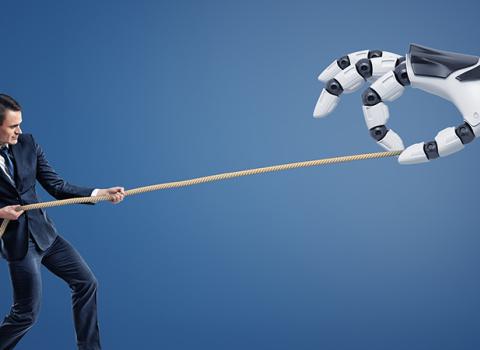
Aldebaran’s Nao is set to be the star player in the next World Robot Cup.
For Bastien Parent, marketing manager of Aldebaran Robotics, even this support represents progress: “Before 2000, the science fiction connotations meant robotics researchers were careful to avoid mentioning the word ‘robot’ in their grants requests.” When it came to getting finance to transfer innovation into robotics start-ups, would-be entrepreneurs had only friends and family to call on.
This is precisely the experience of Bruno Maisonnier. A former director of the bank Credit Agricole, he financed the 2005 launch of Aldebaran Robotics from his own pocket. This provided the company with the means to develop Nao, a 60 centimetre tall android that can walk, talk, recognise faces and voices, and is even up to the finer task of playing football.
Nao has been selected to replace Sony’s robot dog Aibo, as the star player in the next World Robot Cup Standard soccer league, a competition where academic research teams pitch their programming talents against each other in matches between robots.
For Aldebaran, Nao’s call-up has raised a new challenge. To date the company has made only late-stage prototypes, while for the Robot World Cup it needs to produce 40 Naos. The costly manufacturing scale-up will involve recruiting staff including technicians and industrial processes specialists. So robot fan Maisonnier decided to look for a first round of venture capital funding.
To his surprise, VC investors queued up to take a stake in the still-unprofitable company. According to Jean-Michel Deligny from Go4venture, a VC advisor based in London, 20 firms requested the dossier and eight conducted due diligence. In the event, CDC Innovation, the venture arm of Caisse des Dépots, parent company of the French savings bank network, and I Source Gestion, a French VC firm with a focus on early stage deals in information technology, have put in €5 million.
Other robotics start-ups companies are beginning to attract the attention of the VC community. Two more French companies, Robosoft and Naztabag have raised private rounds recently. While a third company, Wanyrobotics failed to attract interest, Nicolas Tomatis, CEO of the Swiss robotics specialist Bluebotics, says, “the field is now clearly of interest to VCs.”
“We received our most recent offer last week,” Tomatis adds. “It seems that VCs are realising that now is a good time to invest in robotics because it is still an emerging field but the market is taking off.”
According to the International Federation of Robotics (IFR) shipments of robots grew by 22 per cent in 2007 in Germany. “It seems that 2007 will go down as the best year ever for the robotics industry,” says Gudrun Litzenberger, head of statistics at the IFR.
Let me entertain you
Industrial robots still have the lion’s share of shipments, but service robots, whether for entertainment like Nao, domestic tasks like the I Robot vacuum cleaner Roomba, or for healthcare, are now growing rapidly in popularity. According to IFR estimates, the service robot market will reach $12.3 billion in 2010, or almost half of the $25 billion it forecasts for the total robot market.
“The industrial robot market is already too mature for VC investing,” explains Valery Huot, partner of CDC Innovation. “But three years ago we started to investigate the field of medical robots. This led us to invest in surgery robot maker Praxim. During the last 18 months we started to look for opportunities in the field of personal robots for entertainment or other domestic uses.”
For Huot, putting money into Aldebaran is likely to be the first of a series of investments in robotics, even though, as yet, the number of potential deals is limited. “We are interested in investing in about 20 companies in Europe, half of them in France.”
The pool of potential investment may not remain restricted for long. According to Parent, “The interest of the venture capitalist community can be explained by significant advances in the area of service and personal robots.”
Since 2000 components have decreased markedly in both size and cost. Technically this means service robots can contain a number of integrated communication devices, have better batteries, and have improved mechanical performance due an increase in embedded processing capabilities.
In economic terms this is bringing the price of robots into line with other consumer electronic devices. Nao for example is set to be priced at the level of a PC for its grand debut on the consumer market, scheduled in 2009.




 A unique international forum for public research organisations and companies to connect their external engagement with strategic interests around their R&D system.
A unique international forum for public research organisations and companies to connect their external engagement with strategic interests around their R&D system.